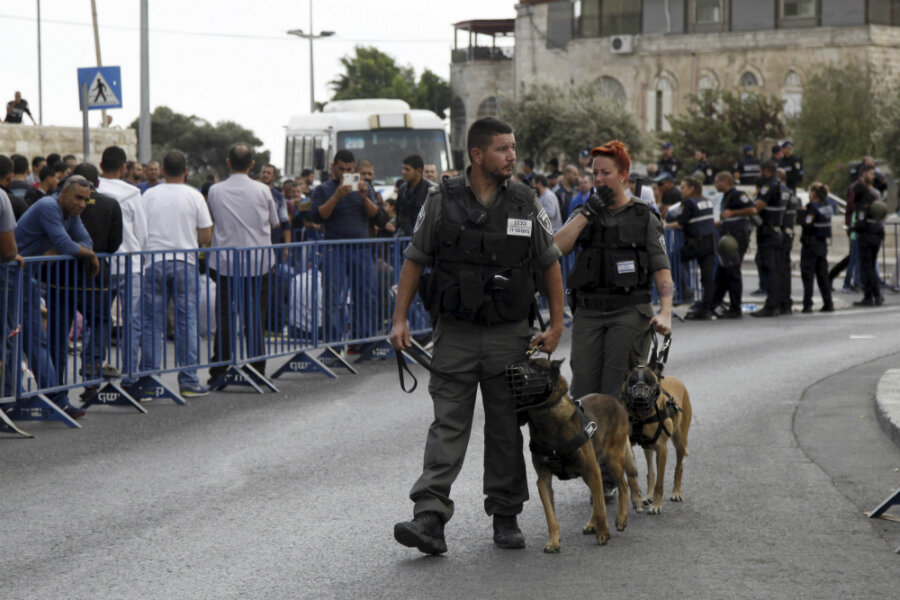Unrest in Israel: How do you stop an intifada that has no leader?
Loading...
| Tel Aviv
The Palestinian uprising that broke out in 1987 was nicknamed the Intifada of the stones. Nearly 13 years later, the uprising that erupted was dubbed the Al Aqsa Intifada.
But if the accelerating wave of stabbing, shooting, and riot over the last few weeks keeps going in, it’s liable to be called the Facebook Intifada. That’s because the upsurge in unrest over the last few weeks has persisted even though there’s no political or military organization actively ordering the attacks until now and Israeli and Palestinian security forces on both sides are trying to cooperate to tamp down the mayhem.
Instead, much like social networks helped spread the uprisings of the Arab spring four years ago and helped the Islamic State gain a following in the Islamic world with beheading videos, an atmosphere of conflict is being fueled by campaigns over social networks. Tweets and posts portray the Al Aqsa Mosque as under threat from Israeli extremists and glorify stabbing and shooting attacks.
“When you block any peaceful way of political expression, there are no parties, and there are no politics, people have no way to exercise influence within the system,” says Orit Perlov, an expert on social media in the Arab world at the Institute for National Security Studies at Tel Aviv University. But “everybody has a Facebook page and a Twitter page; it’s the only place that you don’t have a border,” she adds. “So if you live in Gaza but you can’t move, if you have an idea, it can move.”
A conduit for incitement
Ms. Perlov said Palestinian social networks have been recently flooded with allegations that Israel wants to give Jews more access at the Al Aqsa compound in Jerusalem, and with heroic images of attacks – or so called “operations” – on Israeli civilians.
And even though the Palestinian masses have remained on the sidelines of the current conflict – unlike the first two uprisings – those online allegations have spread an atmosphere of crisis, giving individuals a motivation to strike.
On Wednesday and Thursday, that helped produce a chain of at least six copycat stabbing attacks against Israelis. The attacks are stoking anxiety throughout the Jewish state even though there were no fatalities: political leaders were calling on civilians to carry guns, and security services tightened access to Jerusalem’s holy sites with metal detectors and age restrictions.
Muhannad Halabi, a Palestinian from Ramallah who killed two Israeli men in the Old City of Jerusalem on Saturday, wrote on his Facebook page a day before the attack that “the third intifada is here.’’ Though the Palestinian attackers don’t have large social media followings themselves, it's clear they’ve been influenced by the discourse online, Perlov said.
At the same time, social networks are also used to incite violence against Palestinians among Jews. An Israeli soldier this week uploaded an image to Facebook that read “Hating Arabs isn’t racism. It’s values,” which got thousands of likes before being removed. On Friday morning, an Israeli Jew attacked a group of Arabs in the southern Israeli city of Dimona in an apparent revenge attack.
Prime Minister Benjamin Netanyahu, who was forced to convene a rare press conference amid the crumbling sense of security, acknowledged that most of the violence is the initiative of individuals rather than Palestinian militant groups.
“We are in the midst of a wave of terrorism with knives, firebombs, rocks and even live fire," he said. “While these attacks are mostly unorganized, they are all the result of wild and mendacious incitement."
'You can’t bury ideas any more'
On Friday, at least two Palestinians were killed by Israeli soldiers as the mass rioting spread for the first time to the Gaza Strip border with Israel. A military spokesman said that the fire was in response to repeated attempts by hundreds of rioters to storm the border fence.
An Israeli Army officer, who asked not to be identified because he was not authorized to comment, said that the attacks continue despite calls for calm by the Palestinian leadership against a new uprising and despite security coordination between Israeli and Palestinian security forces. The officer and other security forces accuse the Israel-based Islamic Movement and Hamas of fueling most of the incitement, but said there’s no hard connection or any guiding hand ordering up attacks.
“There’s fuel in the air. It’s a vicious cycle,” the officer says. “There’s an atmosphere of violence and a belief of rallying around the embattled Al Aqsa mosque, which is of course false, and making people do these attacks.”
Still, Israeli security experts say that the absence of mass participation makes the current wave of violence much less severe than the first and second uprising. But the lack of a militant organization makes it harder for security services to tamp down the unrest, says former Israeli Police Commissioner Assaf Hefetz.
"The networks create a climate of emotions that push people to action,” says Mr. Hefetz. “Because it's individuals, intelligence isn’t effective. On the other hand, it's weak terrorism” with much fewer casualties.
Even though both Israeli and Palestinian security authorities have arrested and charged Palestinians for incitement via social networks, Perlov says that there’s no way security services or governments can keep up with Facebook and Twitter.
“You can take pages down, you can find people behind the pages, but you can’t bury ideas any more,’’ she says. “You want to kill an idea? Create a different idea.’’








